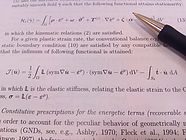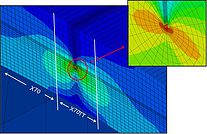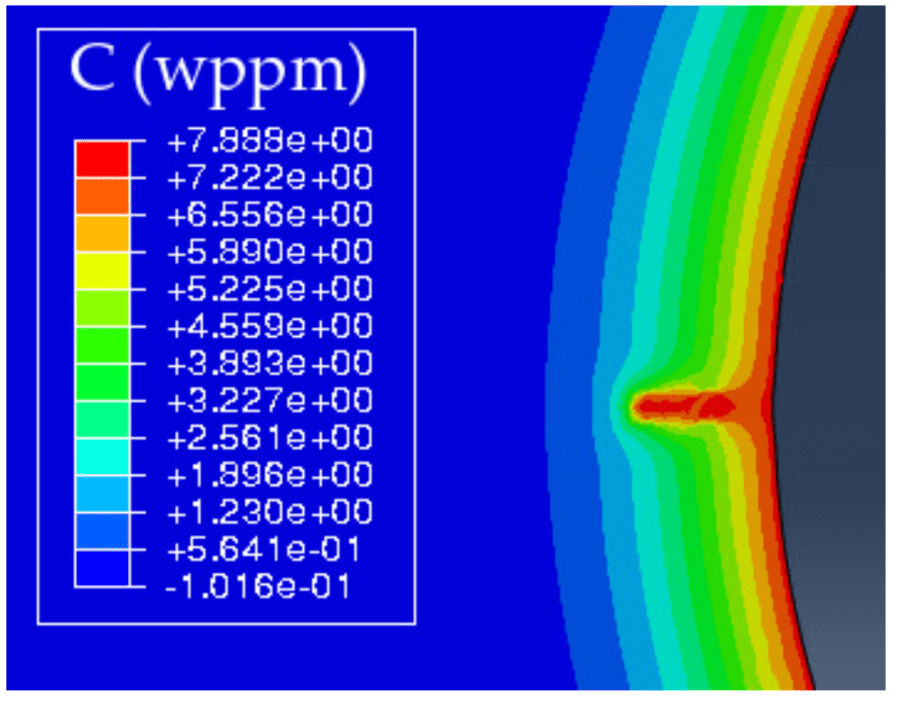Role: PI
Funding: ERC Starting Grant. European Research Council (ERC) | UKRI Horizon Europe Guarantee. 1.5M€. 2024-2029
Developing a new class of materials resistant with an intrinsic resistance to hydrogen embrittlement.
Role: PI
Funding: ERC Starting Grant. European Research Council (ERC) | UKRI Horizon Europe Guarantee. 1.5M€. 2024-2029
Developing a new class of materials resistant with an intrinsic resistance to hydrogen embrittlement.

Role: IP
Funding: Royal Commission for the 1851 Exhibition. 1851 Research Fellowships. £141k. 2018-2021
Micromechanical modelling of rock fracture (RF496/2018). Understanding the micromechanisms governing rock fracture through experimental and theoretical analysis. Development of physically sound models to reduce energy consumption in mining.
The extraction of minerals by mining consumes large amounts of energy, up to 7% of worldwide consumption. Grinding, crushing, and cutting are particularly wasteful; an enormous amount of energy is spent breaking big rocks into smaller rocks. The development of low-energy techniques to liberate minerals from rock has a major impact on sustainability and global warming, and is necessary for economic competitiveness, tougher environmental regulations, and a continuously growing global energy demand. Material models of rock comminution must be developed to help identify the sequence of loadings that promotes cracking on an appropriate length scale and minimises frictional loss between rock fragments. Current empirical models are based on idealised loading in a given direction and are thereby limited in their applicability to more complex loadings for mineral extraction.
A mechanics-based characterization of rock fragmentation will be facilitated by recent advances in experimental capabilities, computational methods and micromechanical modelling of structural materials. Hence, the overall research objective is the development of a ground-breaking constitutive model for micro-cracked heterogeneous rock. Advanced numerical methods will be employed to develop an appropriate computational framework for addressing case studies across time and length scales. The model will be calibrated by a novel set of rock fracture experiments with cutting-edge instrumentation.
Dr Martínez-Pañeda’s experience in micromechanics of metallic materials will be particularly relevant as the project crosses the boundaries of fracture mechanics, geology, and mechanics of materials. The research methodology will benefit from skills transferability in an interdisciplinary effort to bring the geological and structural materials scientific communities closer together with the aim of repeating previous achievements.
As the project constitutes a major step forward towards understanding, modelling and optimising the mechanical response of brittle materials, its range of applicability is enormous. The model will have a major impact on the mining industry, where there is a strong need to liberate minerals at lower energy costs. Specifically, cracking predictions will be used in rock comminution to determine the minimum energy path by a sequence of loading, guiding machine design and operation.

Role: PI
Funding: UKRI Future Leadership Fellowship programme. £1.5M (+£0.5M extension). 2021-2028
New Phase Field Models for Unravelling Multi-Physics Material Degradation Challenges (NEWPHASE). Towards developing a new class of coupled phase field models to unravel challenges such as corrosion and Li-Ion battery degradation.
The biggest scientific and engineering challenges often lie in between disciplines. Through the years, we have gained a good understanding of how materials behave when subjected to mechanical loads (solid mechanics). We also understand the nature of the chemical reactions occurring when materials are exposed to a given environment (electrochemistry). However, predicting material behaviour due to combined exposure to mechanical loads and a degrading environment continues to be an elusive goal. Not being able to understand and predict electro-chemo-mechanics phenomena comes at a great cost since materials are very sensitive to environmental and mechanical degradation in many applications. The value of the fundamental science conducted in this fellowship will be demonstrated on two of these applications: (1) corrosion damage, and (2) Li-Ion batteries. Their importance cannot be emphasised enough. Solely in the UK, failure of structures and industrial components due to corrosion entails a staggering cost of £46 billion per annum. Li-Ion batteries are key enablers in achieving universal access to reliable, clean, sustainable energy.
Now, there is an opportunity to develop models that can prevent corrosion failures and significantly enhance progress in battery technology. Larger computer resources and new algorithms enable simulating concurrent (coupled) physical processes such as chemical reactions, diffusion of species and mechanical deformation; so-called multi-physics modelling. However, the opportunity of building upon the success of multi-physics simulations to predict material degradation is held back due to our inability to model how the boundary between two different phases develops over time. For example, corrosion is often non-uniform, leading to small defects (pits) that grow and act as crack initiators. Preventing the associated catastrophic failures, such as the Morandi Bridge collapse, requires capturing how these defects will nucleate at the electrolyte-material interface and grow. But the modelling of morphological changes in an evolving interface has been long considered a mathematical and computational challenge. I will overcome this longstanding obstacle by smearing the “sharp” interface over a small diffuse region using an auxiliary “phase field” variable – a paradigm change that will make tracking of evolving interfaces amenable to numerical computations. A new generation of models will be developed and validated with powerful 3D techniques such as X-ray Computed Tomography, which have timely experienced notable improvements in spatial resolution and image reconstruction times. By explicitly capturing the damage process, this fellowship will not only open new horizons in the understanding of multi-physics material degradation phenomena but also set the basis for the introduction of simulation-based assessment in engineering practice; model predictions can be compared with inspection data, introducing the “Digital Twins” and “Virtual Testing” paradigms into engineering applications involving demanding environments.
The near-term societal impact will be demonstrated by addressing salient technological problems in offshore energy, batteries, water supply networks and nuclear fission. Efforts will be guided by the fellowship advisory board, which includes leading firms in each of these sectors: EDF Energy, Rolls-Royce, SUEZ, PA Consulting, Vattenfall and Subsea7. For example, the new generation of models developed will be used to assist in the life extension decision of the oldest large-scale wind farm in the world, Horns Rev 1. The lessons learned in this world-first engineering assessment will set an example for the entire sector and demonstrate the potential of computer simulations in enhancing the economic viability of the leading renewable energy source. The successful fellowship will lay scientific foundations for new engineering solutions that will improve UK’s competitiveness and our quality of life.

Role: PI
Funding: EPSRC | Supergen ORE Hub. £100k. 2024-2025
Reliable Corrosion Fatigue Predictions Using Physically-based Models (CF-PREDICT). Development of a new class of corrosion fatigue models, based on the underlying physics, to reliably predict the service life of offshore wind turbines.
Corrosion fatigue is the limit state consideration for the design and in-service lifetime of offshore wind structures. However, there is a consensus that the empirical corrosion fatigue estimates currently used are inappropriate, as they are based on very limited data and strongly simplistic assumptions. CF-PREDICT will provide a new path for the wind energy sector to rigorously assess design, maintenance, and end-of-life decisions. We will demonstrate how state-of-the-art, physically-based computer models can accurately predict the reliability and durability of offshore wind turbine support structures, replacing or complementing current empirical procedures.

Role: PI
Funding: UKRI | Engineering & Physical Sciences Research Council (EPSRC). £457,833. 2021-2025
Next Generation Electro-Chemo-Mechanical Models for Hydrogen Embrittlement (NEXTGEM). Development of efficient and reliable models for predicting hydrogen uptake and embrittlement. Extending the success of Virtual Testing to the energy industry.
Hydrogen is ubiquitous and has two faces. On the one hand, it is at the core of the most promising solutions to our energy crisis. Hydrogen isotopes fuel the nuclear fusion reaction, the most efficient potentially useable energy process. Moreover, hydrogen is widely seen as energy carrier of the future and the most versatile means of energy storage. It can be produced via electrolysis from renewable sources, such as wind or solar power, and stored to be used as a fuel or as a raw material in the chemical industry.
On the other hand, hydrogen is widely known to cause catastrophic failures in metallic materials and structures, hampering these opportunities. Metals become brittle when exposed to hydrogen-containing environments, with the fracture resistance decreasing by up to 90%. This so-called hydrogen embrittlement phenomenon not only jeopardises the role of hydrogen as a potential solution to the global energy crisis but also constitutes one of the biggest threats to the integrity of the current energy infrastructure. The problem is particularly severe in aggressive environments, such as those experienced by the offshore industry, as corrosive mitigation strategies like cathodic protection exacerbate the production of hydrogen. Moreover, hydrogen embrittlement is becoming increasingly notorious due to the higher susceptibility of modern, high-strength steels. Decades of metallurgical research have led to the development of metals with high and ultra-high strengths. These modern alloys open new horizons in reducing weight, material use and costs while increasing performance and safety (fatigue resistance). For example, ultra-high strength steels are essential in meeting targets on CO2 emissions through vehicle weight reduction. However, the susceptibility to hydrogen embrittlement increases with material strength and the increasing uptake of these new high-performance materials has made hydrogen assisted fractures commonplace across a wide variety of sectors and applications in otherwise benign environments, from bolt cracking at the Leadenhall tower to rail failures in underground systems. There is an urgent need to understand the multiple physical mechanisms behind this hydrogen-induced degradation and develop models that can predict failures as a function of the environment, the loading conditions and the material properties.
This EPSRC New Investigator Award aims at developing a new generation of models that can predict local hydrogen uptake and subsequent cracking by resolving the electrochemistry-diffusion interface and shedding light into critical uncertainties in surface behaviour and trapping. An accurate estimation of hydrogen ingress for a given bulk environment is the main bottleneck preventing the application of current chemo-mechanics models in engineering assessment. Occluded areas such as cracks, pits or other defects exhibit very different chemistry to the bulk environment, and local measurements are unfeasible apart from controlled laboratory experiments. NEXTGEM will merge mechanics with electrochemistry, combining experiments, multi-physics modelling and Bayesian inference to resolve the scientific challenges holding back the applicability of hydrogen embrittlement models. This new generation of electro-chemo-mechanics models for hydrogen embrittlement will be used to enable a safe use of high strength alloys, optimise material selection and inspection planning, and prevent catastrophic failures.
The project involves world-renowned academic collaborators with expertise complementary to that of the PI and leading firms in the offshore energy sector, operating the oldest large-scale wind farm in the world (Horns Rev 1). The applicability of the models developed will be demonstrated by continuous monitoring of critical components, in a piece of proof-of-concept research that can have wider implications across the transport, defence, construction and energy sectors.
